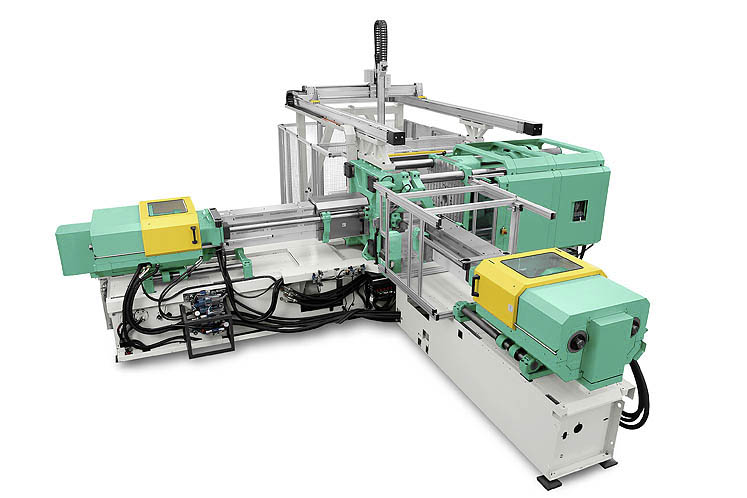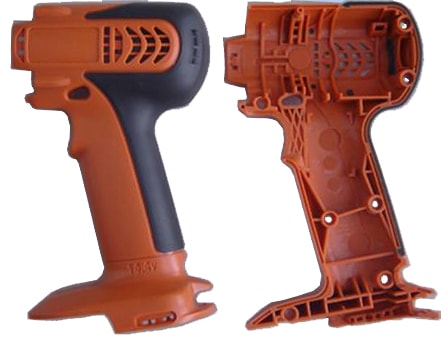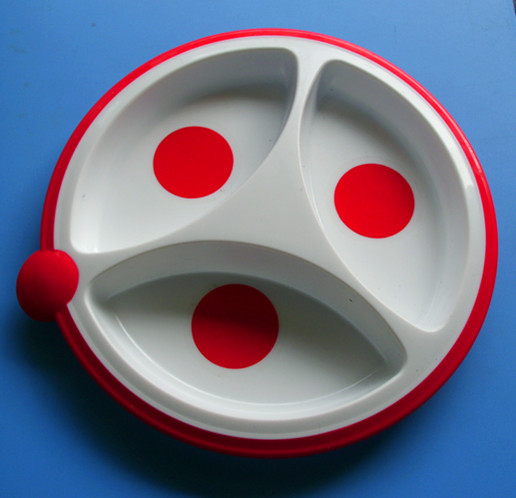Bi-material injection in a few words

Bi-material plastic injection also called bi-injection is a process of two successive moldings using two different thermoplastic materials for the production of a plastic part.
This process is used when producing parts:
- Incorporating two colors
- Made of two different materials having rigid and flexible areas, or with a technical part in one material and a part in another material more suitable for the desired appearance.
- Rigid with areas having a “grip” or “soft touch” effect
Bi-material injection enables developing sealing functions by molding sealings directly onto the affected part, without going through the assembly step. But it also offers the ability to delete an operation, as everything can be done automatically on the injection press.
The various types of bi-material
plastic injection molds
There exist four main types of bi-injection molds:
- Transfer molds: The part is transferred manually or robotically in the same mold for a second injection.
- Molding with a rotary plate: The mobile side of the mold makes a 180° rotation to place the first molding into the cavity of the second material. This rotation is ensured by the platens of the press.
- Molding with a rotating base: This is the same principle as the mold with a rotary plate, but this time the rotation mechanism is in the mold. The partially mobile cavity leaves the mold assembly and makes a half turn before returning to its housing.
- Mold with core-back process: The space for the second injection is made through a movement of the core.
The distinctive features of
bi-material plastic injection molds
Bi-injection or bi-material mold manufacturing requires expertise in multi-material plastic injection and in plastic overmolding. As an expert in plastic injection tooling, Unimold controls the mold design, as well as the choice of material and the injection configuration.
The three main technical difficulties in bi-material injection are:
- Shrinkage: The shrinkage of the first injection must be taken into account, and the resulting dimensional differences when closing. Deformations resulting from shrinkage must be controlled.
- Venting: To ensure the second molding, a perfect seal is required but this can lead to burr problems.
- Filling: The second injection is made with plastic that has little resistance to injection pressure of the second raw material. In some cases, the second injection can bend the plastic insert. It is then necessary to balance the injection or the position of the plastic insert.
Mechanically, the bi-material molds are generally more difficult to produce. The fittings and adjustments will be more complex.
The fabrication of bi-material
plastic injection molds
Beyond the mold maker’s expertise necessary for the fabrication of bi-material plastic injection molds, the manufacture of this type of tooling is similar to other traditional plastic injection molds.
However, the test phase can be problematic, due to the existence of several types of bi-material injection presses. Some injection has a second nozzle at the back of the mold next to the main one. Others are placed at 90° on the top and some at 90° on the side opposite the operator.
At Unimold, our test centre allows us to test the molds under serial conditions and ensure the necessary adjustments.
The main applications for
bi-material plastic injection molds
Mechanical differentiation
Bi-injection allows for two different materials having distinct properties on the same part. It is often used to add a soft or non-slip area to a part such as a handle. The overmolded material is generally styrene-ethylene-butylene-styrene (SEBS) or thermoplastic polyurethanes (TPU).
On the same principle, bi-injection enables adding a seal or a sealing part.


Aesthetic differentiation
The use of two different plastics allows differentiating the colors.
The part is mass-colored and will not fade with time.
